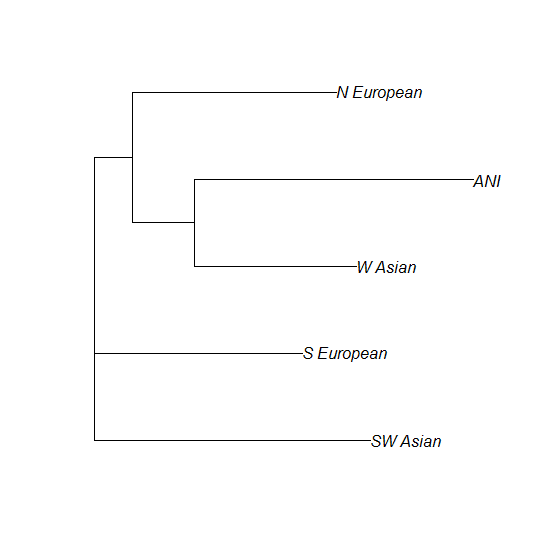These (selected) geographical groups of auDNA ar based on modern pops, I think. When we compare the distrbutions in Great Europe and Near-East, we see a very unequal ratio of 'gedrosia'/caucasus'. The supposed steppic part of north-western (and Basques) seem very more 'gedrosia' than 'caucasus'. The contrary for Slavs Greeks and partly Italians. I wonder if 'gedrosia' is not the more eastern (or northeastern) part of 'west-asian', more ANE, and less crossed with a 'levant'like part (or 'Basal Euro' part?). If we look at some amateurs DNA breakings for very ancient pop's of north-Asia we see 'gedrosia' too. So surely 'gedrosia' doesn't contain a lot of 'south-asian' elements... If we take all that seriously, we could think the most of our supposed I-Ean ancestors came at first from a rather eastern position or picked their 'caucasus' element, close to Caspian, maybe eastern or northeastern Caspian..Some russian metrics found (uncomplete) ties with S-E Caspian people among BA Steppic.
ATW it's curious analysing ancient pops with modern pops auDNA? in some way...
With this last same problematic, we can suppose diverse (by drift) WHG parts in 'northsea' and 'atlantic'.
well, I will try to be concise and straight to the point. I think we all should try to be as synthetic as possible and as precise as possible, since, although modern genetics have supposedly more precision than some older anthropological and racial studies, it lacks in concrete representations, it is too abstract(haplogroups and such are just random acronyms combined), we can't precise geographic origins of genomes and sometimes even physical apperance get lost. It must be representative in order to be useful, many papers and articles talk about percentages and create computadorized calculation models(still suppositions), but lack in describing appearance or approximating the genetic data to more concrete racial groups and populations.
1- I find it very inappropriate to take modern populations as reference for the modelling. If they use current Gedrosian populations that is bad, since these same Gedrosians have partial Yamnaya ancestry and Caucasian ancestry( Caucasian Hunter Gatherers and ANE). Considering Gedrosia was once part of Persia and other eastern indo-european empires, it would make some sense to have it, but then it must be defined what exactly is gedrosian.
2- According to Allentoft and Haak et al(2015), the component in Yamna was like 55-85% EHG, 15-25% CHG(here understood and mixed also the Gedrosian element) and around 6% WHG. The trick here is that this EHG already had from 10-30% WHG, so the overall WHG would be higher. And the CHG is the Gedrosian or whatever you want to call it, associated with paternal haplogroups J1 and J2, especially J2b and maternal H, T and K mostly. So I think after all, the Gedrosian element is the CHG. In his article, besides some neolithic farmers crossing the Caucasus and settling around the Volga region(early neolithic J2b samples), some R1b tribes most likely crossed the Caucasus to the Iranian Plateau/Northwest Iran, and there they absorbed this CHG element, sometimes identified as Gedrosian because they are kind of the same. This would explain why Yamna culture was much more advanced than neighbouring EHG cultures and where it got the copper metallurgy from(from neolithic cultures in Transcaucasia). We have to bear in mind that most samples from Yamna were elite Kurgan samples with almost exclusively only one subclade of R1b(R1b-Z2103), the later subclades associated with Celts, Italics, Germanics etc are absent. It indicates the perhaps this elite had more Caucasian/Gedrosian ancestry than the remaining population, since the percentage is only around 10% in later Bell Beaker and Unetice cultures, a 150% reduction. Part of it can be explained by the absorbing of local populations, but not all, so the gedrosian/caucasian element should have been somewhat unequal in Yamna. The higher Caucasian(especifically caucasian) element in italians, greeks and slavs could perhaps be attributed to two factors: previous neolithic farmers rich in caucasian ancestry, and indo-europeization of caucasian rich peoples, mostly greeks and armenians in this case. Ancient greeks and Hittites had frequently armenoid/caucasian features. We can't explain completely how it happened, armenians and anatolians had Yamnayans coming down the Caucasus, greeks also to an extent with possible other J2 peoples(indo-europeized) going up around the Black Sea. Additionally there seems to have been some introgression of Caucasian genes in elite indo-europeans other than those of Gedrosia, we see that in the somewhat high concentration of J2 in southern Europe and even southern Central Europe(Rome, Venice, Greece, Austria etc), Neolithic farmers almost didn't have J2 in their paternal lines, so these must have arrived there with indo-european migrations. These J2 were indo-europeans and had different physical characteristic of other middle eastern populations, usually lighter skin, warlike cultures, possibly more robust or taller, lactase for the processing of milk(typical of indo-europeans), immunity to certain animal carried diseases, sometimes lighter hair or eyes etc. We know that both EHG and EEF had light skin, WHG not so light and other neas easterners also not so light. So I think we can see a cluster between Yamnayans, EHGs and EEFs regarding light skin, milk processing, immunity and other traits. Indo-europeans are a cultural and linguistical definition with a genetic basis, but this genetic basis is not ANE, but the specific peoples that gathered in the Pontic Steppe during later Neolithic/Chalcolithic.


